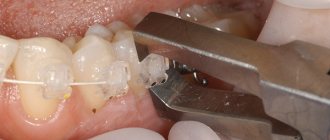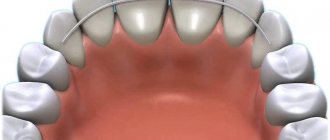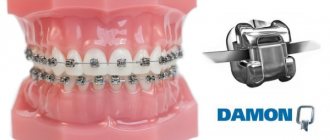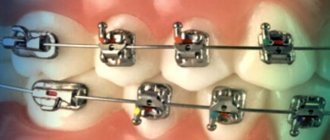Chief editor of the site:
Snitkovsky Arkady Alexandrovich
Chief physician of the professorial dentistry “22 Century”, dentist, orthopedic dentist
Author of the article:
Scientific team of dentistry “22 Century”
Dentists, candidates and doctors of medical sciences, professors
Gingivoplasty involves the removal or formation of gum tissue
For a beautiful and even smile, not only well-groomed teeth are important: healthy gums play an equally significant role. Unfortunately, complaints about the condition of the gums are very common .
One of the most common and aesthetically unpleasant defects is irregular periodontal contour : receding, lifting or uneven distribution of gums along the dentition. This worsens the appearance of the teeth and can lead to more serious diseases: for example, gum recession until the root is exposed can lead to caries and other disorders.
Gum plastic , or gingivoplasty, which involves the removal or formation of gum tissue, which helps improve their appearance and structural condition, will help to cope with this problem
Main indications for gum surgery
Gingivoplasty is performed in the following cases:
- To remove excess periodontal tissue - for example, to eliminate the so-called “shark smile”, when part of the tooth is hidden under the gum;
- To correct the smile line - in the case when the gums on different teeth are not the same in length;
- To level the height of the gum during its recession (excessive elevation), including when the neck of the tooth is exposed;
- In case of periodontal disease, when periodontal pockets can no longer be restored;
- For active prevention of root caries and periodontal diseases;
- To improve the structure of gum tissue;
- To achieve a high-quality cosmetic effect during patchwork operations.
- For orthopedic indications - for beautiful and reliable prosthetics.
- For successful prosthetics on implants.
Changes in the condition of the gums very often occur in old age - approximately 80-95% of all cases.
Also, factors such as:
- Chronic inflammation in the oral cavity (periodontitis, periodontal disease);
- Congenital structural features of the dental system (bad bite);
- Traumatic damage to the gums;
- Bad habits (chewing a pencil, etc.);
- Improper brushing of teeth;
- Errors in previous treatment or dental prosthetics, etc.
Thanks to plastic surgery, the patient has the opportunity to restore the required volume of gum tissue .
Possibilities of gum plastic surgery
According to its anatomy, the gum consists of two parts - mobile and fixed (near the teeth). Normally, the mucous membrane is pale pink in color, without bleeding or pain. The gingival margin is not very mobile. Only a few millimeters of gingival sulcus are allowed - this is the depression between the tooth and the edge of the gum.
There are also gums of different biotypes - thin, medium, thick. These are quantitative characteristics that sometimes need correction before implantation, for example.
Gingivoplasty of the gums will help:
- Improve the quantitative characteristics of the mucosa: increase its thickness and volume;
- Get rid of deep periodontal pockets, that is, ensure a tight fit of the gingival margin to the neck of the tooth;
- Correct the contour of the gums, make it aesthetically beautiful;
- Raise the level of the edge of the mucosa when the gums recede (recession);
- Remove excess gum if it interferes with teething or with its hypertrophy (overgrowth).
Gingivoplasty: indications
All types of gum surgery are aimed at achieving the main goal - restoring normal function and anatomy. Cosmetic problems are often accompanied by deviations from the norm, so in this case we can equate health and beauty.
A small aesthetic problem can lead to complications in the future, so gingivoplasty in any case is not done at the whim of the patient.
Dental gum plastic surgery for medical reasons is performed when:
- Difficulties in teething when part of the tooth or its entire edge is covered with mucous membrane. By removing its excess, you can give the tooth the opportunity to fully erupt, as well as visually improve your smile.
- Receding gums or recession. This pathology is accompanied by exposure of the neck and root part of the tooth, due to which these parts may suffer from increased sensitivity, caries, and abrasion (this tissue is less durable, so even a toothbrush causes a wedge-shaped defect). Also, during recession, the gingival margin looks uneven, and there are gaps between the teeth.
- Preparation for implantation. To install an implant, the volume and quality of the gums must meet certain standards. Expensive and serious treatment cannot be put at risk, so before dental implantation, gum bone grafting and gingivoplasty are always prescribed to eliminate problems with periodontal tissues.
- Treatment of periodontal diseases. Gingivitis, periodontitis and periodontal disease are diseases of the oral mucosa, so they are inevitably associated with pathology of its characteristics. With hypertrophic gingivitis, when the gum covers more than 2/3 of the tooth crown, its volume can be reduced to normal, thereby eliminating pain and bleeding during eating and hygiene. With periodontitis, you can eliminate tooth mobility, remove the source of chronic infection, and remove periodontal pockets. The result is a tight fit of the gingival margin to the teeth and almost complete elimination of inflammation.
Gum plastic surgery during implantation (during the course of treatment) is also necessary - with its help, additional volume of the mucous membrane is increased, the mobility of the implant is eliminated and the gums are corrected after bone grafting. Also, gum plastic surgery after implantation will allow you to prolong your health for decades, because even a seemingly insignificant defect in the mucous membrane can become more complicated over the years: the uneven edge will inevitably be injured by food, and the gum pocket will be filled with plaque, tartar, followed by inflammation.
Plastic surgery of soft gum tissue for cosmetic reasons:
- If the edge of the gum is uneven, the mucous part of the tooth is covered, or it is excessively exposed, all this visually spoils the aesthetics of the smile and puts the patient’s dental health at risk;
- If necessary, correct any unevenness after other operations or anatomical imperfections: remove excess mucous membrane, epulis (epulis) or other gingival growth.
Gingivoplasty: contraindications
Surgical intervention, although it cannot be called truly serious and extensive, still has contraindications.
Absolute:
- Chronic diseases in the form of decompensation: diabetes, cirrhosis, tuberculosis, HIV, kidney disease, heart disease, lung disease and others;
- Blood diseases and oncology;
- Alcohol and drug addiction, smoking more than 1.5 packs per day;
- Mental illness (not all).
Temporary:
- Infectious, inflammatory, respiratory diseases in acute form;
- Pregnancy.
Acute conditions can be cured, and chronic ones can be kept under control - in this case, with proper preparation, there are no contraindications for gingivoplasty.
Types of gingivoplasty
Gum plastic surgery is usually performed at the end of flap operations , which end with the closure of gum defects in the neck and root of the tooth with periodontal flaps.
The second type of gingivoplasty is a delayed surgical intervention, which is performed after the gums have completely healed.
And depending on the scope of gum treatment, there are operations performed on a general basis , on all (or almost all) teeth, or on a localized area.
Methods and types
The main objectives of plastic surgery are to restore the normal appearance of tissues, edges and restore the attractiveness of the smile. This is done at the expense of neighboring areas, but when contouring it is necessary to excise the excess, that is, trimming. The operation is performed by a surgeon, anesthesia is usually local, but at the request of the Patient, general anesthesia can be used. The duration is short, there are no complications or severe pain. The recovery period does not take much time.
Treatment methods depend on the disorder and the desired result. You must first cure all existing diseases, including caries, and remove stone and soft plaque. There are several options for operations, these could be:
- restoration, bone transplantation;
- transplantation of flaps from the palate if generalized recession is observed;
- cleaning pockets, restoring the area by exfoliation and further application of a flap.
With any chosen method, preliminary diagnosis is required. This allows you to avoid complications in the future and choose the optimal surgical procedure. After the intervention, sutures are placed on the affected area, which can be removed after about ten to twelve days.
Your doctor may prescribe the following types of gingivoplasty:
- after performing a patchwork operation, when covering defects or deformation of the gingival margin near the root, neck of the teeth;
- surgery, carried out some time after the treatment and tissue healing, is performed with the aim of restoring the frontal zone and returning an attractive smile.
There are also surgical interventions performed on a localized area or generalized, that is, for a large area. It all depends on the degree of damage, stage of the disease and deformation.
Methodology
The goal of gum surgery in case of periodontal tissue deficiency is their restoration at the expense of neighboring parts of the oral cavity. When contouring gums, on the contrary, excess gum tissue is removed. The operation is performed by a periodontist surgeon under local or general anesthesia, depending on the patient’s wishes.
Before performing gingivoplasty, it is necessary to heal all carious cavities and remove existing acute inflammatory processes.
During the operation, the doctor makes an incision in the gingival margin as close to the tooth and cleans the root surface of dental deposits, plaque and food debris.
The further course of the operation will depend on the type of plastic surgery: for example, with local recession, incisions are made in the area of the periodontal pocket, resulting in detachment of the flap, which is applied to the exposed area. If the recession is generalized, then fragments of soft tissue are transplanted from the palate. If necessary , procedures aimed at transplanting or restoring bone tissue are performed during the operation.
After all manipulations, the edges of the wound are sutured using a non-absorbable polyamide thread and a temporary bandage is applied to it. Stitches are usually removed after 10-12 days.
Complications
If treatment is performed in a timely manner and the operation is performed correctly, there will be no complications. But possible problems include:
- tooth loss;
- development of inflammatory processes;
- difficulties in prosthetics.
If any signs of worsening of the condition appear, it is recommended to consult a doctor. This will help eliminate possible risks and deterioration.
Postoperative care, healing time
After plastic surgery of the gingival margin, swelling, sensitivity, redness and some pain are observed. But they all pass quickly and stop bothering the Patient. To speed up the recovery period, it is recommended to follow the following measures:
- brush your teeth carefully without touching the operated area;
- rinse your mouth regularly using antiseptics;
- stop smoking, drinking alcohol, temporarily exclude spicy, smoked, and solid foods from the diet;
- eliminate physical activity, protect the sore area from the risk of injury.
The rehabilitation period is individual and depends on the primary degree of damage and the treatment methods used.
About Us
The “Two Dentists” dental clinic offers Patients the following advantages:
- services of doctors with over 8 years of experience;
- individual approach;
- full range of services, including diagnostics;
- certified materials;
- modern high-tech equipment;
- attractive price;
- 5 year guarantee on dental work performed.
To make an appointment or get more information about performing gum recession surgery, leave a request on the website. You can find out prices or consult on other issues by calling. The request can also be sent to
Postoperative period
After gingivoplasty, some side effects are possible - swelling, redness, increased tooth sensitivity. For quick rehabilitation and the absence of complications, you must follow the surgeon’s recommendations and regularly come to the clinic for examination.
For several days after the operation, it is advisable to follow the following recommendations:
- Rinse your mouth regularly and brush your teeth very carefully;
- Give up bad habits: smoking can lead to inflammation of injured tissues;
- Follow the diet: eat soft foods, avoid very hot or cold foods;
- Do not expose yourself to physical stress.
Thus, having more carefully understood what gingivoplasty is, it becomes clear that this is a simple, but at the same time very effective operation.
Gingivoplasty - correction of gum contour
The cost of the procedure is 2000 rubles
For a beautiful smile, a harmonious relationship between teeth and gums is important. If the front teeth look small and short, and when you smile there is a lot of gum exposed, this is a so-called “gummy” smile. Most of the tooth is under the gum, which is why it looks short.
This problem can be solved quite simply without harm to the teeth and surrounding tissues. A gum correction procedure is carried out, namely the removal of “excess” gum that covers the tooth. This type of gum surgery (or gingivoplasty) can significantly improve the aesthetics of your smile.
Is this intervention painful?
The procedure is performed under local anesthesia and the patient does not feel anything.
Is it possible to predict the outcome of this procedure? What will the gums look like after healing?
Even before treatment begins, the new gum contour is modeled using conventional filling material. It is temporarily applied over the gum, visually lengthening the tooth. And, if the result meets expectations, plastic surgery is performed along the modeled contours. Such modeling allows one to fairly accurately predict the future outcome even before intervention.
Is this procedure harmful to teeth or gums?
During gum surgery, only a small part of it is removed (on average, 0.5-1.5 mm), which can in no way harm either the teeth or gums. The procedure also has no long-term consequences.
Are there any contraindications?
Inflammation of the gums. If there is one, it must first be eliminated.
Why do we use laser to correct gums?
Traditional techniques for excision of excess gum tissue are performed using a surgical scalpel. Laser methods are superior to traditional ones in a number of parameters.
- High precision removal of even minimal amounts of gum tissue with high precision.
- Ability to remove minimal amounts of tissue with high precision.
- Fast recovery after the procedure. The laser beam cauterizes the blood vessels and no stitches are required. The slight swelling disappears within a few days.
- Less traumatic. Much less discomfort for the patient after the procedure.
- Absolute sterility of the procedure.
In what cases is gum correction performed?
- To correct a “gummy smile”
- Uneven, asymmetrical gums. The gum level may be lower on one tooth than on another, giving the appearance that one tooth is longer than the other.
- Preparing the gums before installing veneers, crowns or before teeth whitening procedures to achieve the best aesthetic results.
The procedure is often combined with other dental procedures, such as veneers, dentures, and teeth whitening.
Gum correction + veneers
Gum correction+4 crowns
What to expect after gum correction
There may be some swelling and soreness after the procedure; this is completely normal. This discomfort is minimal. During the first few weeks after the procedure, it is important to continue to practice good oral hygiene, but use caution. The tissue that has been treated may remain sensitive for some time. While recovering from the procedure, you should eat soft foods to avoid worsening your discomfort. Do not use mouthwash with alcohol as it may burn sensitive tissue.
Attention!
Progressive recession of the gum tissue can lead to tooth loss , as a result of which it will be necessary to replace it with prosthetics, which will cost much more than the cost of gum surgery.
If you need help with issues related to the condition of your gums, contact our dental clinic.
Date of publication: September 20, 2020 Last update: September 22, 2022 © 2020 Professorial Dentistry “22 Century”. All rights reserved.
Gingivoplasty
To create an aesthetic appearance of gums, gingivoplasty can be performed according to several techniques:
- Gingivectomy – surgical correction of the gum edge by removing gum pockets. During this operation, excess gum tissue is excised, which allows the gum to be given a beautiful shape. Indications for gingivectomy also include the need to prevent inflammation of tooth roots and bone tissue, as well as the lack of results with conservative treatment of periodontal diseases;
- vestibuloplasty is a surgical operation that is performed in the vestibule of the oral cavity and allows you to increase the volume of the gums to hide the exposed roots of the teeth;
- excision of the hood is an operation that is usually used for difficult teething. A hood is a bump on the gum that often forms near the wisdom teeth. Food debris accumulates under it, which leads to inflammatory processes. Excision of the hood allows you to solve a number of hygienic problems and ensure normal growth of teeth.
Any of the above types of gingivoplasty, as a preparatory stage, involves professional cleaning of the oral cavity and treatment of existing carious cavities. Next, the surgeon begins the step-by-step operation. First, under local anesthesia, he makes an incision and performs curettage - removing plaque and deposits from the tooth root. If the patient has local gum recession, the doctor cuts the edges of the periodontal pocket, peels off the flap and covers the exposed area of the tooth with it. If the recession is generalized, flaps from the palate are transplanted. At the end of the operation, neat sutures are applied. Gingivoplasty is performed in one visit to the dentist.
Contraindications
Despite the fact that gingivoplasty is a simple procedure, there are contraindications to its implementation:
- Respiratory diseases.
- Oncology.
- Poor blood clotting.
- Allergy to anesthetics or other contraindications to anesthesia.
- Diabetes.
- Bone diseases.
Surgery on gums and dental diseases should not be performed. If stomatitis or periodontal disease is diagnosed, they must first be treated.
Stages of the procedure
- Sanitation of the oral cavity. This stage is carried out before any dental surgery. The oral cavity must be healthy.
- Anesthesia. The operation is usually done under local anesthesia. In case of panic, the doctor may suggest sedation or general anesthesia.
- Antibacterial treatment. In order to prevent the risk of inflammation of the operated gum area, the oral cavity is treated with antibacterial agents.
- Formation of gingival flaps. To do this, the doctor makes an incision in the gum in two places and peels off the flaps.
- Curettage of dental pockets. This stage is necessary in order to remove plaque and stone from the base of the tooth.
- After the cleaning procedure, the doctor adjusts the shape and size of the internal flap and returns it to its place. Next he will cover the inner flap
external and will close them.
When indicated, osteoplasty is performed during surgery. Synthetic materials are used to build bone tissue. Osteoplastic material is placed under the internal gingival flap. For additional protection and better survival, the osteoplastic material is covered with a membrane. After this, the internal flap is returned to its place, covered with the external one and sutured.
On average, the operation takes about an hour. Since gingivoplasty is a surgical intervention, over the next 2-3 days the swelling of the gums persists and the sensitivity of the teeth increases. To prevent inflammation after the procedure, the doctor will prescribe anti-inflammatory drugs. When the operated gum is very painful, you can take painkillers.










